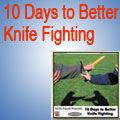
|
Straight Blast Defense: Don't Panic!
by Keith Pascal
Those of you who follow the philosophy of Bruce Lee probably
A Straight Blast is basically a rapid series of punches. Most
So, in essence, our reader, yes this article is in response to
We need to think about three aspects of self defense when taking
A lot of people panic when those quick hits come flying in. What
Hmmm. We are starting to turn our fear, our disadvantage,
Depending how early they start their attack, you have several
*If your attacker starts punching beyond a kicking
*If your attacker tries to Straight Blast you from
*If your attacker is just about to step into your
You'll need precise timing with all of the above responses. Figure
Taking a Straight Blast from the inside (trying to counter attack
It's much easier to counter from the outside. Personally, I step
Here are some tips to make this kind of counter more effective:
*You need a fraction of a second to reverse the attack.
*Your goal is to get your attacker to punch past you,
*The tighter the angle, the better to slip this series
*A lot of martial artists can't vary their Straight
*If all else fails, run away... or kick. Don't be limited by
As I mentioned before, once I have slipped the initial onslaught of
Once you have taken the blast, you could follow up with your own
So, what about those pros out there who don't start Straight Blasting,
Do I sense a need for another article?
(Thanks to Bong Sao Bec for the article suggestion)
In Bruce Lee's Book, Striking Thoughts: Bruce Lee's Wisdom
"I follow the line of the hard bone. I do not attempt to cut it,
See if you can respond by "not contending with it in any way."
BTW -- Bruce Lee goes on to explain how to apply this principle
Even though the ultimate finesse is to counter the move by
I am still driving in and not blocking.
If you'd like to read more about this technique look for the
Remember, Bruce Lee also said "efficiency is anything that
Again, write questions to me about this subject ... or not.
Readers who enjoyed the above article also liked the following article: These Articles Are Just the Tip of the Icebergby Keith PascalI hope these articles are of value to you. Did you know that The Punch Papers is a collection of over 40 articles all about punching harder, faster, and more efficiently? Plus, more new punching chpater have been added. You really get to sink your teeth into a subject. You gain skills.
This ebook is filled with great punch improvement advice. I guarantee it!
Martial Arts Mastery: A Tell-All of Tips, Tactics, and Techniques (Free, weekly martial arts ezine -- filled with practical tips. |
FREE
Weekly martial arts
ezine filled with practical tips
Martial Arts
Click on the link in
Mastery
sell your name or
email address.)
email will be sent
to your email
address.
the email, to start receiving your
combat course.

Kerwin Benson Publishing
2749 Friendly St., Suite 200
Eugene, Oregon 97405
USA
 Is it time for you to punch like a professional? Click here.
Is it time for you to punch like a professional? Click here.

